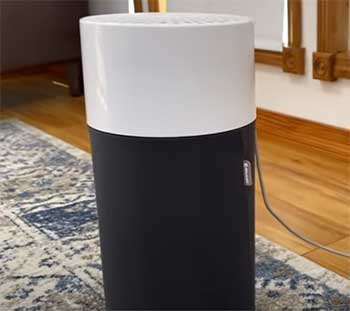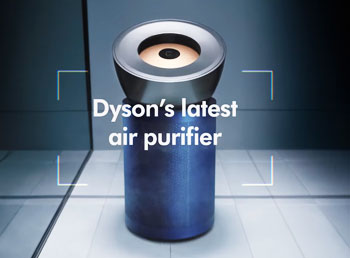Indoor air quality has become a top concern for many homeowners in recent years. From pet dander to cooking fumes, there are many sources of air pollution within our homes. That’s why more people are turning to air purifiers to remove allergens, odors, and other pollutants.
Blueair and Dyson are two of the most popular air purifier brands on the market. But which one is right for you? This comprehensive guide examines the key differences between Blueair and Dyson air purifiers across a variety of factors:
A Brief Comparison Table
| Feature | Blueair | Dyson |
| Filtration technology | Electrostatic, HEPASilent | 360° Glass HEPA filter |
| Coverage capacity | Up to 775 sq. ft. | Up to 1,500 sq. ft. |
| Noise level | 17 – 56 dB | 40 – 77 dB |
| Filters | Washable pre-filters, replaceable particle/carbon filters | Pre-filter, 360° HEPA filter, activated carbon filter |
| Smart capabilities | App control, air quality monitoring | App control, air quality monitoring, auto mode |
| Design | Rectangular, plastic/metal | Futuristic, mostly plastic |
| Prices | $199 – $749 | $349 – $799 |
As you can see, Blueair and Dyson have some noticeable differences when it comes to design, noise levels, and smart features. Keep reading for an in-depth look at each brand’s strengths and weaknesses.
Overview of Blueair Air Purifiers
Founded in Sweden, Blueair has been making air purifiers since the 1990s. Their devices use a combination of electrostatic and mechanical filtration (HEPASilent technology) to capture airborne particles.

Here are some key things to know about Blueair air purifiers:
- Filtration Technology – Blueair’s HEPASilent filtration combines electrostatic charging with mechanical filtering. This allows their filters to efficiently capture even the smallest particles down to 0.1 microns. The filters consist of polypropylene fibers and are completely ozone-free.
- Coverage Capacity – Blueair models are rated to clean anywhere from 190 to 775 square feet. The larger Classic 480i and 680i can cover extra large rooms and open floor plans.
- Noise Level – Running at the lowest fan speed, most Blueair units produce only 17-46 decibels of sound. Even at max speed, noise levels range from 31 dB to 56 dB. These are very quiet operation ranges, making them ideal for bedrooms and home offices.
- Filters – Pre-filters can be vacuumed or washed to extend their lifespan. The particle filters and smokestop filters (with activated carbon) need replacing every 6-12 months depending on usage.
- Smart Capabilities – Select models can connect to the Blueair Friend app for remote monitoring, control, and air quality alerts. Some also have built-in air quality sensors.
- Design – Blueair purifiers have a minimalist, Scandinavian-inspired aesthetic with rounded corners and plastic or metal exterior. They come in white, black, gray, and blue color options. The filters are concealed behind fabric covers.
- Cost – MSRP ranges from $199 for the small Blue Pure 211+ up to $749 for the extra large Classic 680i. Replacement filters cost $50-$130.
Overview of Dyson Air Purifiers
Dyson is best known for their innovative vacuum cleaners, but they also make some of the most advanced air purifiers. Dyson purifiers use patented 360° Glass HEPA filters to remove allergens.
Key features of Dyson’s air purifying fans include:
- Filtration Technology – Dyson uses 360° Glass HEPA filters that capture 99.97% of particles down to 0.3 microns. This includes pollen, pet dander, mold spores, and bacteria. The filters are made of compressed borosilicate glass layered with TPE polymer.
- Coverage Capacity – Dyson purifiers are capable of cleaning large rooms up to 1,500 square feet. The tower-style HP07 covers up to 800 sq. ft. while the TP07 and BP01 models can handle 1,500 sq. ft.
- Noise Level – These are not the quietest models, with noise ranging from 40dB on the lowest setting up to 77dB on max. The tone is described as an airflow “whooshing” sound.
- Filters – A foam pre-filter protects the glass HEPA filter. An activated carbon filter also captures gases, VOCs and odors. Filters should be replaced every 12 months.
- Smart Capabilities – Dyson Link app enables monitoring air quality, scheduling, switching modes, and tracking filter lifespan. Auto mode automatically adjusts fan speed based on airborne pollutants.
- Design – Dyson purifiers feature a sleek, futuristic look with hollow bases or loops amplifying airflow. Durable plastics in silver, white, black, or gold finish. Oscillating tower or round pedestal shapes.
- Cost – Retail prices go from $349 for the TP01 up to $799 for the HP07. Replacement filters cost around $80.
Also Read: Differences Between Mila And Blueair Air Purifiers.
Key Differences Between Blueair and Dyson
Now that we’ve covered the basics, let’s do a deep dive into how Blueair and Dyson models compare across seven key factors:
Filtration Technology

- Blueair uses HEPASilent filtration combining charged polypropylene fibers with mechanical filtering to trap particles. This hybrid electrostatic and mechanical method allows their filters to capture contaminants as small as 0.1 microns. The filters contain no chemicals or coatings.
- Dyson uses Glass HEPA filters made of compressed glass layered with TPE polymer. The dense glass weave can capture particles down to 0.3 microns with 99.97% efficiency, including allergens and bacteria. Dyson filters contain no fibers that can shed or wear out.
- Both filter pollen, smoke, dander effectively. Blueair also filters slightly smaller particles, but Glass HEPA filters tend to better maintain airflow over time.
Coverage Capacity
- Blueair models are made for small to extra large rooms from 190 up to 775 square feet. The Pro XL can clean an area up to 775 sq. ft.
- Dyson air purifiers cover up to 1,500 square feet for the tower models like TP07 and BP01. The smaller HP07 has an 800 sq. ft. capacity ideal for large rooms.
- Dyson offers greater maximum coverage capacity overall. But Blueair still accommodates moderately sized rooms of up to 680 square feet.
Noise Levels
- Blueair units operate very quietly from 17 dB on the lowest settings to 56 dB on max speed. This makes them unobtrusive for bedrooms and offices.
- Dyson purifiers produce 40 dB up to 77 dB of airflow sound. The tone is described as a loud yet soothing “whoosh”. Not ideal for sleep or work spaces.
- Blueair air purifiers are significantly quieter across all fan speeds. Dyson models can get quite loud on higher speeds.
Smart Features
- Blueair has optional connectivity via the Blueair Friend app for remote control, air quality monitoring, filter changes, and scheduling. Some models have built-in particle sensors.
- Dyson Link app enables real-time air quality reports, graphing, filter status, scheduling, modes, and voice control. Auto mode automatically adjusts fan speed based on contaminant levels.
- Dyson offers more robust smart capabilities like air quality visualization, auto mode, and broader voice assistant compatibility. But Blueair still has solid app integration and sensors.
Also Read: Comparison Between uHoo and Airthings
Design Aesthetic
- Blueair features simple, minimalist rectangular designs with rounded corners and plastic or metal build. Available in white, black, gray, and blue colors with fabric filter covers.
- Dyson has signature curved, futuristic designs largely made of durable plastics. Models come in silver, black, white, and gold finishes with hollow bases or airflow loops.
- This comes down to personal preference. Dyson has flashier, almost sci-fi appeal. Blueair opts for flexible, low-key Scandinavian chic.
Filter Costs
- Blueair pre-filters can be vacuumed instead of replaced. Particle filters cost $50-$130 and last 6-12 months. Carbon filters are around $80.
- Dyson filters cost around $80 and need replaced every 12 months. Pre-filters may need cleaning every 3 months.
- Blueair replacement filters tend to be a bit cheaper. But filter durations are similar for both brands when following recommended timelines.
Price Range
- Blueair air purifiers range from $199 for the small Blue Pure 211+ up to $749 for the extra large Classic 680i.
- Dyson air purifier prices go from $349 for the TP01 up to $799 for the high-end HP07 tower model.
- Blueair starts off less expensive for smaller units, but pricing is comparable for the larger, high-end models from both brands.
Also Watch This Review Video:
Pros And Cons Of Blueair & Dyson
All things considered, Blueair and Dyson take somewhat different approaches to air purification. Here’s a quick rundown of their major pros and cons:
Blueair Pros
- Very quiet operation
- Slightly better filtration for smallest particles
- Flexible coverage capacities
- Minimalist, neutral design aesthetic
Blueair Cons
- Limited smart capabilities on some models
- Replacement filters can get pricey
Dyson Pros
- Can clean very large spaces up to 1,500 sq. ft.
- Advanced smart features like auto mode and air quality reports
- Bold, eye-catching design
Dyson Cons
- Noisier across all fan speeds
- Bulkier footprint for smaller rooms
- Higher upfront cost for entry-level models
Ultimately, there are great reasons to choose either brand. Blueair is ideal if you prioritize silent operation and simpler controls. Dyson offers greater power for large rooms and technologically advanced purifying. Assess your space, needs, and budget to decide which suits your situation.
Also Read: Comparison Between IQAir and Dyson
Frequently Asked Questions (FAQs)
Yes, Dyson’s air purifying units utilize a fan to draw air through the filters and project cleaned air back into the room. This allows their purifiers to cover larger areas compared to passive units. All Dyson models include oscillation for improved circulation. The fan and filter work together to both purify and circulate air.
There are a few key reasons to consider a Dyson air purifier: Powerful 360° Glass HEPA filtration that captures 99.97% of particles down to 0.3 microns. Can clean extra large rooms up to 1,500 square feet.
Advanced smart features like air quality monitoring, auto mode, scheduling, and app control. Sleek, futuristic designs with curved lines and durable plastics. Brand reputation for engineering and performance.
No, Dyson air purifiers do not have built-in cooling or air conditioning functions. They improve air quality by removing pollutants, but will not lower the temperature in your room. However, the strong airflow created by the fan can help make a room feel cooler. It circulates the air, creating a wind chill effect that may make a hot room feel fresher. But it will not change the actual heat level or act as an AC unit.
Yes, Dyson air purifiers excel at capturing fine dust particles. Models with 360° Glass HEPA filters are able to trap 99.97% of particles as small as 0.3 microns. This includes most dust, pollen, pet dander, mold spores, and more. The powerful airflow circulates room air through the filters multiple times per hour to continually remove dust. Dyson devices can dramatically cut down on visible dust buildup.
Also Read: Comparison Between the 311 and 411
Final Thoughts
Improving your indoor air can make a huge difference in comfort, health, and wellbeing. Both Blueair and Dyson make high-performing air purifiers, but with some trade-offs. Blueair prioritizes ultra-quiet operation, while Dyson packs in smart features and max power.
Think about room sizes, noise tolerance, design preference, and tech needs. This will steer you towards the right brand for your home.
While the upfront investment is significant, an air purifier that efficiently filters pollutants for years to come is well worth the cost. Cleaner indoor air leads to better breathing and living.
